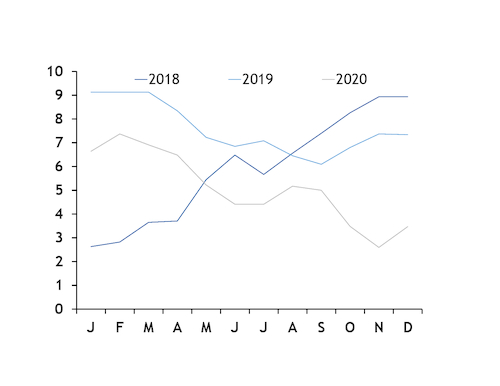

(Montel) Atlantic basin coal prices have retreated from multi-month highs seen earlier this week in line with related markets, but signs of a tightening supply outlook may limit losses.
The front-quarter API 2 contract eased 2% on the week to USD 52.30/t, while the front year was little changed at USD 57.60/t, Ice Futures data showed.
The contracts on Tuesday reached their highest levels since mid-January and mid-February respectively, of USD 55.50/t and USD 59.80/t.
Participants said API 2 prices had largely been tracking moves on related markets, with gas, power and carbon prices also having been on the decline since Tuesday.
“I think it’s the energy complex and freight [driving the market], not fundamentals,” said an analyst with a coal producer.
The Baltic Dry Index – which tracks global dry freight rates – on Monday hit its highest since September, of 1,956 points, but has since eased more than 7%.
“The support for [freight rates] was from China, for iron ore and coking coal, and this is seasonal, so from the freight perspective, we may have passed the peak, which would be negative for API 2,” said a coal analyst with a European energy firm.
But she noted API 2 losses may be limited, amid some adjustment in the Atlantic basin supply-demand balance, with relatively sharp reductions in output anticipated this year from Russia, Colombia and the US.
In Russia, exports in the first half fell 6.3% on the year to a five-year low for the period, provisional government estimates showed, as producers took steps to reduce global oversupply and support diminishing prices.
Exports totalled nearly 88m tonnes, around 6m tonnes down from the same period last year, while production fell 8.5% to 195m tonnes.
“[Russian exporters have] inevitably been doing their job in order to balance the market,” said a coal strategist with a European trading firm. He said Russian exports this year may decline as much as 15m tonnes versus 2019.
Similarly, Colombian miners expect reductions in output, due in part to the impact of the coronavirus on operations, while the US could see exports down more than 30% this year, according to EIA estimates.
“I would expect a downside risk overall, everything combined, but how miners respond remains the biggest thing for 2020,” said the energy firm analyst.
Lower stocks
Combined coal inventories at four key northwest European dry bulk terminals this week declined nearly 2% to a three-week low as slack utility demand resulted in a slowdown in vessel arrivals.
Inventories at Amsterdam, Rotterdam and Antwerp (ARA), at 6.04m tonnes, were down 15% from the same time last year but much in line with the first-half 2020 average of 6.06m tonnes, Montel estimates showed.
Stocks averaged 6.75m tonnes in the first half of last year. A source at Rotterdam’s largest import terminal, EMO, said vessel arrivals were “quiet” for the time of year, with no coal-laden vessels scheduled to discharge at the terminal this week.
While a complete absence of arrivals for an entire week was an unusual occurrence, arrivals were seasonally slower over the summer months, he said. Coal burn across Europe declined 27.5% in the first half of this year, according to data from Finnish technology group Wartsila, with the fuel accounting for less than 12% of total power generation.
This in part reflected a broader 6% decline in total power generation, from all sources, as efforts to stem the spread of the coronavirus hampered industrial activity.
But it was also due to significantly more favourable generation margins for competing gas and growing renewables capacity.
Connect with and follow Montel News on Twitter:
[tfws username=”montelnews” height=”700″ width=”350″ theme=”light” color=”#FAB81E” tweets=”2″ header=”yes” footer=”yes” borders=”yes” scrollbar=”yes” background=”yes”]













